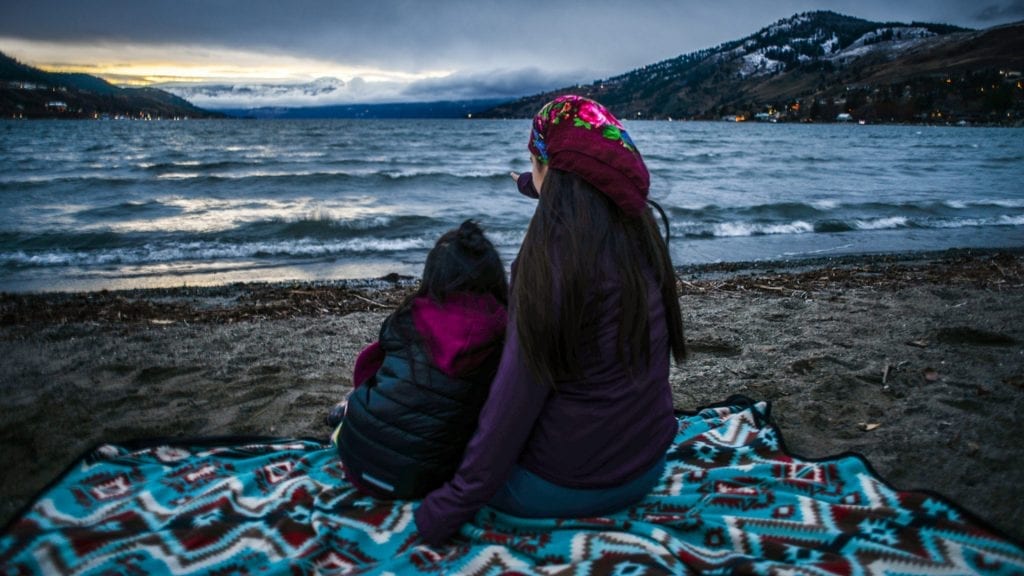
Smklxn, showing young Powitchiwa the snow on the mountain-tops, signifying it’s time to start telling stories. Photo by Kelsie Kilawna
As snow falls gently on the kekuli — a winter pit-home in the Okanagan — Syilx people gather with their children to share Captikwł stories.
Sometimes animated with big gestures to keep the young ones’ attentions on the morals and values of the story, sharing Captikwł is something people in the Okanagan have always reserved for the winter months.
Elder Rob Edward, a former chief of Lower Similkameen Indian Band, says this time-old practice of sharing Captikwł still continues today, and it’s a lot more than a social exercise. It’s a complex story system designed to pass on important information.
“It’s a doctrine for a transfer of knowledge for all of our laws and protocols, how we are to be with one another, ceremony, prayer, giving thanks and place names,” he says. “All of that is really important.”
Before COVID-19 hit, families were still gathering in the kekuli in wintertime to listen to these stories, however, now with the pandemic that might need to turn virtual.
Edwards says that this important work must continue so that the spirit of the Captikwł is maintained.
“It gives us the knowledge that we need that comes from the beginning of our existence,” he says.
“It’s really important to our people, it helps with our environmental ethic, our business ethic, all of the ethics we need to survive on this land.”
Winter is a key time for storytelling in many Indigenous nations because it’s a time to rest after a year of preparing for the winter through harvesting, hunting and ceremony.
He says some Captikwł stories can take weeks or even months to fully tell which is why that stillness is important.
“If you tell it in the summer then you lose what you are trying to teach in our discipline,” Edwards says.
“[Captikwł time] stops when the buttercups come out, and then when the first snows come in at the top of the mountains then you can start telling Captikwł in its entirety.”
During those times of preparation in spring, summer, and fall, Edwards says older folks will tell the young ones to “‘stand there and be quiet and listen” and watch ceremonies take place.
When the younger ones observe and witness the ceremony, they relate it back to the stories they heard during the winter, as a form of developing a disciplined mind and memory for those important teachings.
“So it’s always making those connections, and those Captikwł have those connections to each other, they are not siloed,” Edwards continues.
“They all have an interconnection to one another. So do our ceremonies, our songs, and all those different things.”
He says Captikwł not only tells Syilx people how to connect with one another, but how to create kin with non-human beings such as plants and animals.
The stories bring to life important places that hold natural laws, and a good storyteller is key to ensuring the information is passed along properly.
“The storytellers are really good,” he says. “They are animated, some of them, some are really serious, and they have really high language in there. They really know how to engage people.”
Edwards says that a Western, colonial school system means Captikwł — or a Sqilxw (people of the land) way of thinking in general — is generally not taught to children outside of their own kinship systems.
“They say you have to teach this, this, and that, because they don’t want our thinking in there,” he says.
“Our young people, we always push them to be smart in school and say, ‘you gotta be this, you gotta be that, you gotta be this doctor, this lawyer’ or something like that. But what about a storyteller?”











